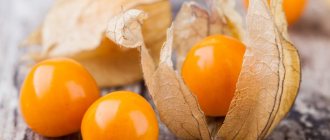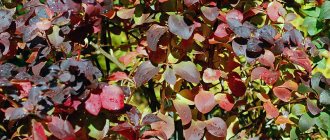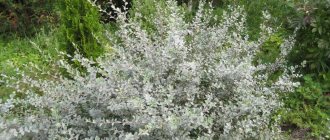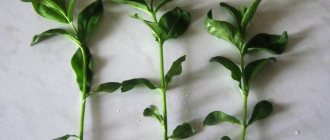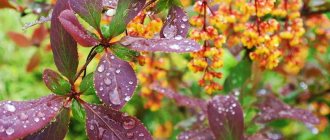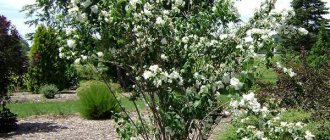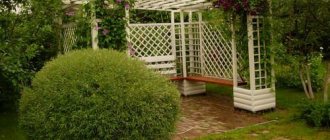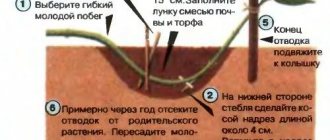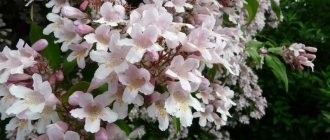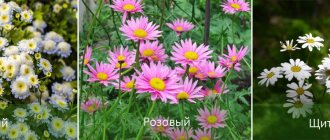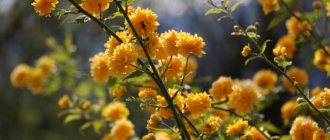Planting barberry
Conditions for growing barberry
Before you begin planting work, you need to decide on the landing site. The plant is perennial and voluminous; it is necessary to think about its location in adulthood in advance. In addition, despite its unpretentiousness, the plant still has requirements for soil and location.
- When choosing the optimal place to plant barberry, stop in an open area with the maximum amount of light on it. In the shade, the plant will grow and develop, but the leaves will lose their bright color, and fruiting will be at risk.
- Barberry tolerates drought more easily than excess moisture. For this reason, barberry should not be planted in lowlands. Choose the highest and most open area, and if groundwater is close, take care to build high beds or embankments for a flower bed.
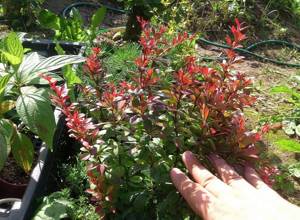
- If you plan to have one barberry bush, leave a space of 1.5 meters around it for it. If a barberry hedge is planted, place it in a checkerboard pattern over 1 sq.m. 3 or 4 bushes. In this case, remember to regularly thin out the branches so that the fruits receive the maximum possible light.
- The soil for barberry should have average acidity.
- The timing of planting barberry depends on the type of root system. A barberry seedling with a closed root system can be planted in the garden at any time of the year, except winter. If the root system of barberry is open, choose spring or autumn, but remember that planting barberry in autumn will harden and strengthen the plant, and in the spring it will begin to grow.
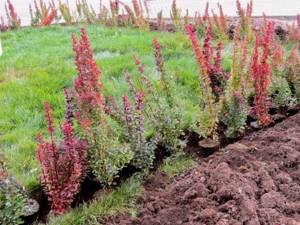
Let's look at planting barberry step by step:
- Prepare the area for planting in advance. If spring planting of barberry is chosen, it is better to begin preparation in the fall; this measure is necessary to reduce the risk of burns of barberry roots by fertilizers. Remove weeds, dig up the soil with applied fertilizers, based on the nutritional value and acidity of the soil.
- The pit for barberry has standard dimensions: a square with a side of 40 cm. Pour water into the bottom of the pit and wait for it to drain. Add a drainage layer: a layer of crushed stone, then a layer of sand. Fill the hole halfway with prepared soil mixed with lime and fertilizer.
- Plant the barberry seedling in the hole and fill in the remaining soil. Make sure that the root collar is not submerged in the soil and is above the ground.
- Water the seedling and mulch the surrounding area with peat or compost.
- Trim the barberry seedling, leaving only 5 or 6 healthy buds.
Planting site, soil
Chrysanthemum Bacardi - planting and care in open ground
Barberry is planted in open ground in autumn or spring. The procedure is performed in the evening. How quickly barberry grows depends on compliance with planting rules and choice of location.
When landing, adhere to the following conditions:
- the selected area has deep groundwater;
- watering only during dry periods;
- lack of shadow;
- a windless place protected by buildings, outbuildings, and a fence;
- loose fertile soil or loam;
- soil acidity pH 4–8.
It is better to plant barberry in the fall. In this case, the bushes have time to take root. But if you come across the desired option in the spring, it is advisable to purchase it with a lump of earth.
Planting barberry in open ground
A deep hole is chosen for the seedling, since drainage, an earthen ball, and soil are placed there. You also need a wide space to spread out the roots. When planting several plants, prepare a trench.

Planting a plant in open ground
There is drainage at the bottom. This is a layer of pebbles, gravel or broken bricks. The soil mixture is poured on top of it. It is bought in a store. Or take garden soil with mineral fertilizers. This is followed by abundant watering.
Additional Information! Before placing the seedling in the hole, a peg is driven into it. This is a support for a young, unrooted plant.
After watering, the seedling is carefully placed in the hole. The roots are carefully straightened. If there is a clod of earth, there is no need to straighten the roots.
The hole is filled with the rest of the soil and compacted by hand so that the root collar is at a depth of 3–4 cm.
This is followed by abundant watering and mulching of the tree trunk circle. Sawdust or fallen leaves are used.
Growing from seeds
Growing barberry from seeds is a long, but realistic task. Since the crop has seeds with a hard shell, stratification is carried out for 2–5 months at a temperature of 5 °C. Peat or sand is used.
Seeds sown in autumn undergo stratification in the ground. The seedlings are left in the same place for 2 years, then transferred to a permanent place.
Properties
The plant is unpretentious, resistant to drought, frost, durable, and is popular when grown in the country. The shrub has straight, prickly branches; the thorns in some varieties can reach a centimeter. The young bush is spreading, then it grows and becomes an insurmountable obstacle. This quality is used for hedges. Barberry is also used for individual and group plantings. It is easy to trim, so it is widely used in landscape design.
Mature plants reach three meters in height, but there are dwarf varieties of thirty centimeters. The bushes grow very quickly and are able to renew themselves even after radical pruning.
Not only the responsiveness to haircuts attracts landscape designers, but also the extraordinary decorative effect throughout the year.
Clusters of small yellow flowers attract attention in spring. Bright green glossy foliage delights the eye all summer, and in some varieties it shimmers with variegated, yellow, and burgundy flowers
In autumn the bushes turn purple. Clusters of bright red barberry fruits decorate the bushes until spring.
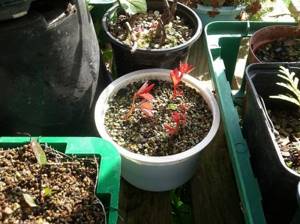
When to plant barberry
You can plant barberry in open ground in autumn and spring. But in most of Russia, gardeners prefer to plant in the spring. In this case, the risk of seedlings freezing is practically zero. In autumn, barberry should be planted in open ground in early September. This will allow the seedling to take root before frost sets in.
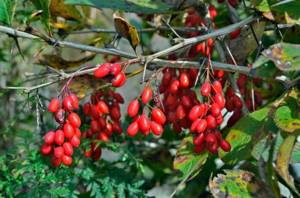
Barberry is best planted in spring
Features of spring planting
Barberry is unpretentious to the composition of the soil. Therefore, it can be planted in any area. However, there are a few basic rules to follow when planting shrubs:
- Barberries are planted early, as soon as the snow melts. Planting of seedlings at this time is carried out because the bush is one of the first to wake up after wintering. Planting work must be completed before the buds swell.
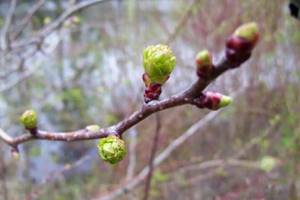
Barberry buds “wake up” early
- The area for planting shrubs should be well lit. Barberry can grow in the shade, but the yield is greatly reduced.
- To plant one barberry seedling, a planting hole of 40x40 cm is dug. The depth is approximately 0.5 m.
- To create a barberry hedge, planting is done using the trench method: rows are made 40–50 cm deep, and seedlings are placed in them at a distance of 0.5 m from each other.

Seedlings are placed at a distance of 50 cm from each other
- Despite all its unpretentiousness, barberry does not really like acidic soils. Therefore, when planting in such soil, it is better to add slaked lime (500 g per 1 m2).
- The shrub should not be planted near groundwater.
- When planting in loamy soil, you need to add peat to the soil.
How to plant barberry correctly
In order not to harm the shrub, you need to plant correctly:
- The planting hole or trenches are prepared 2 weeks before planting the shrub.
- Half a bucket of sand is poured into the bottom of the hole. It has a beneficial effect on the root system.
- Then the hole is filled with a mixture: soil mixed in equal proportions with humus and peat. You should also add superphosphate (30–40 g per 1 m2).
- The seedling is lowered into the prepared hole.
- The roots are sprinkled with earth and compacted.
- The plant is watered abundantly.
- The soil is mulched with straw, peat or sawdust.
- After planting, it is necessary to prune the seedling so that no more than 3-4 buds remain on the branches.
- In the first days after planting, the shrub should be protected from the sun.
Weather conditions also affect the planting of barberry. The plant is not planted in open ground on hot days. It is best to choose cloudy weather for planting.
Common Mistakes
It is not difficult to propagate barberry. However, beginners make mistakes. The most common of them:
- Incorrectly selected cuttings. The length and number of internodes is strictly limited. A branch that is too long will not be able to fully feed, and a short one does not always take root.
- The greenhouse effect has a beneficial effect on survival rate. But it’s worth ventilating the greenhouse once a day. Sprouts need fresh air.
- Too much fertilizer in new soil can burn the roots of the shoot. Add additives strictly according to the instructions.
- It is not recommended to use fresh manure to feed new plants. It contains a large amount of nitrogen, which causes burns.
- Abundant watering is good. But everything should be in moderation. If a lot of moisture accumulates in the ground, the roots and lower part of the cutting will rot.
- When selecting cuttings, they are cut only with a disinfected tool. You can't break off branches. The cut should be oblique, not straight.
- Be sure to use a root former, so new roots will not keep you waiting.
- Cover young bushes for the winter; winter hardiness is not fully evident until the age of three.
Yellow barberry
Thunberg's barberry and its propagation by cuttings are almost no different from other varieties. You need to follow the rules and useful tips and the new shrubs will definitely take root.
Barberry is a wonderful plant that delights gardeners not only with its flowers, but also with its berries. They are used for completely different purposes: they cook compotes, preserves, bake pies and prepare syrups. Shrubs are great for landscape design. They are planted along the fence (it turns out to be a beautiful green hedge).
Features of planting in the regions
There are no differences when planting barberry in different regions of the country. But the difference in climate affects the choice of variety and plant care.
Barberry in Siberia
Although barberry is a frost-resistant plant, some species are still less suitable for growing in Siberia. These are Thunberg barberry, Korean barberry, entire barberry. You can choose common barberry, Amur barberry, and oblong barberry. For the winter, it is recommended to cover the young bush - along the edges with a spruce forest, and then, when snow falls, to make a snowdrift. Large plants are tied with twine, a box is installed into which dry leaves are poured. The structure is wrapped with non-woven material on top. The soil around the plant is mulched.
Barberry in the Moscow region
Culture feels good in the climate of the Moscow region
It is only important to provide the bushes with a lot of light and water-free soil. Common barberry, Thunberg barberry, and Ottawa barberry are excellent for growing in the region.
Video: growing Thunberg's barberry
Barberry is one of the most unpretentious shrubs growing in Russia. We can say with confidence that with proper planting and proper care, it will take root in any garden plot, delighting you with a good harvest and colorful appearance from year to year.
Planting and caring for barberry in Siberia
Beginning gardeners often ask the question of whether barberry can be grown in summer cottages in Siberia. The answer is yes.
This shrub is not afraid of frost, and it is not afraid of drought. Although the plant is considered a light-loving plant, it can be grown in areas with little shade.
But when planting, you need to take into account that barberry does not like marshy soil. It grows poorly on saline soils; heavy soils will also become an obstacle to its cultivation.
The shrub grows best on loam, but you need to ensure that there is a sufficient amount of organic matter in the soil. The soil must be well drained.
Preparing for sowing
The collection of barberry for seeds begins in November - early December. The collected fruits are placed in a bowl and lightly kneaded, being careful not to damage the seeds. After this, they are left in a warm place for several days for fermentation, so that the pulp can be easily separated from the seeds. This is done using a sieve, then the seeds are immersed in water to wash them and determine whether they are suitable for sowing: they will end up at the bottom of the container, while the empty ones will float up. The preparation of seeds for sowing is completed by drying them until they flow.
Seeds prepared by this method have up to 95% germination rate. If you are going to sow them in the spring, then they will need to be kept in a room at a certain temperature - from two months to six months.
How to use it in landscape design
Landscape designers value this plant for its all-season decorative properties. In the spring it decorates the garden with sweet-smelling flowers, in the summer it pleases with bright foliage, in the fall the crown of the barberry changes color and becomes even brighter, and even in winter the bush continues to delight the eye with the colored bark on the bare branches. Barberry berries, which appear in late summer or early autumn, also add their own accents. In addition to color, they are also notable for their shape: oval, round, oblong and even pear-shaped.
Many varieties of barberry bear fruit very profusely
Having become acquainted with a dozen varieties of barberry, it is impossible to doubt that it will be appropriate in any area. This plant is most in demand in the following areas:
curbs along paths. Typically, low-growing varieties are planted this way, for example, barberry Thunberg Aurea or Admiration, which form a dense edging of the path and do not interfere with admiring more distant plants;
hedges
Here it is important to choose bushes with lush crowns and rapid regeneration, so that they tolerate pruning well (important for maintaining a neat shape of the hedge. Red Pillar or Red Rocket (for a low hedge), ordinary (if you need a high hedge) are perfect)
The plant quickly increases in size, so the optimal distance between seedlings in the hedge is 25–35 cm;
rockeries and alpine slides. Depending on the designer’s idea, both low-growing (up to 0.5 m tall), compact spherical bushes and columnar varieties will suit the yard. When it is necessary to increase the visual volume of a composition, barberry with a lush crown is often used (for example, Red Carpet or Kobold);
single plantings (tapeworms). Most often, medium-sized bushes (with a spreading crown or columnar) with yellow-green or red-purple leaves are selected for accents. Single green barberry bushes also look very good, given a decorative shape by pruning (topiary, geometric shapes, figures);
edge in group plantings. When a composition of tall trees is planted, barberry helps to hide the unattractive bare trunk and make the flower bed more fluffy. Tall varieties of barberry can act not only as an edge, but also as the main accent of group planting.
Landscape designers also pay attention to the compatibility of plants with other species. Barberry is an excellent friend of all conifers, from pines and spruces (especially blue ones) to thujas (they do not have needles, but branched plates)
In hedges, barberry is successfully diluted with other tall shrubs: lilac, jasmine/mock orange, wisteria. Despite the fact that the bush becomes bright in the fall, it can become an excellent background for September flowers, asters and chrysanthemums.
Here barberry makes excellent friends with other bushes and herbs
Under no circumstances should you plant barberry next to cherry, walnut, white acacia, elderberry, or poplar. Such neighbors will oppress him and the bush will wither. This is due to the fact that these plants release substances that are dangerous to barberry from their roots. Fallen leaves of these species have the same effect, so it is advisable that the wind does not carry them under the berry bush.
If we talk about the color of its neighbors, then barberry can set off any shades of greenery, you just need to choose the right variety.
Barberry in Siberia: types and cultivation, beneficial properties and use in design
Barberry is one of the most attractive shrubs for landscape design. The variety of varieties with different leaf colors, good tolerance to pruning, after which barberry retains its shape for a long time, make this plant very popular as a garden decoration. But not only does barberry boast of its beauty, it is also well known for the fact that the fruits, leaves, and even the roots of this shrub are beneficial to health.
Useful properties of barberry
Barberry is one of those rare plants, all parts of which are beneficial to health. The healing properties of barberry have been the most studied.
- Ripe barberry berries are not only tasty and are successfully used as a seasoning for food, but also very healthy, as they contain large amounts of ascorbic, malic, citric, tartaric acid and vitamin K. Juice from the berries is a valuable vitamin supplement.
- The unripe fruits are known to contain the alkaloid berberine, which is used in the treatment of liver and gallbladder diseases.
- Tincture of barberry leaves and roots is used to stop uterine bleeding.
- Root extracts are used to normalize digestion, they reduce inflammation of the mucous membranes; a decoction of barberry roots can be used to rinse your mouth for gum inflammation.
This is a versatile shrub that you can easily grow in your garden. It will give you pleasure with its beauty, diversify your dishes with its sweet and sour taste, prevent illness and even treat if necessary.
Growing barberry in Siberia
The question is often asked: “Can barberry grow in Siberia?” And the answer to this question is: “Of course it can.”
- Barberry is a frost-resistant and drought-resistant shrub.
- Barberry is a light-loving plant and grows successfully where there is a lot of light.
- Does not like waterlogged, heavy and saline soils. Loamy, well-drained soils with a sufficient amount of organic fertilizers are most favorable for it.
- Immediately after planting, plants are watered abundantly, and then once a week at the rate of 5-7 liters of water per plant.
- They begin to fertilize from the second year after planting, applying nitrogen fertilizers in the spring (20 g of urea per 10 liters of water), fertilize once every 3 years.
- Acidic soils must be limed when planting; the optimal pH value should be 6.5 - 7.
- Barberry needs annual pruning to maintain its decorative qualities.
- The shrub is propagated by seeds and cuttings.
Types and varieties of barberry for Siberia
When choosing a plant for growing in harsh regions, it is necessary to take into account the characteristics of the type and variety of the plant. Grows well in Siberia:
- common barberry, dark purple form,
- Amur barberry,
- Siberian barberry is generally endemic to Siberia - it grows quietly in the wild in the harsh Siberian climate.
You need to be careful when choosing varieties of Thunberg barberry - often its winter hardiness is not enough to survive our winter frosts.
Source
Disembarkation rules
Even a novice gardener can cope with planting barberry in open ground, since this ornamental shrub does not require special knowledge and skills, but it is worth taking a closer look at the nuances of planting.

Optimal timing
Initially, you should pay attention to the timing of planting this plant. If we consider spring and autumn, then it is better to give preference to spring planting, although we should not forget about the climate characteristics of the area in which you live. For example, if summer in your region is dry and hot, then you should ensure sufficient watering, since barberry is a moisture-loving plant.
If this is not a problem for you, then planting can be done in the spring. If it is not possible to water regularly, then it is better to plant barberries in the fall. It is worth waiting for the leaves to fall, when the plants are preparing for winter hibernation. This option will be excellent for growing barberry in the Moscow region
For example, if summer in your region is dry and hot, then sufficient watering should be provided, since barberry is a moisture-loving plant. If this is not a problem for you, then planting can be done in the spring. If it is not possible to water regularly, then it is better to plant barberries in the fall. It is worth waiting for the leaves to fall, when the plants are preparing for winter hibernation. This option will be excellent for growing barberry in the Moscow region.
Barberry is an unpretentious plant, so it can be cultivated even in Siberia. The main thing is to create moderate soil moisture and provide optimal lighting. The decorative value of barberry does not depend on air temperature or humidity, fertility and composition of the soil in which it grows.

Selecting a location
When growing barberry, it is necessary to take into account both climatic and weather conditions. You need to know what kind of lighting he likes, the acidity and fertility of the soil mixture, as well as the degree of moisture. If you live in an area with a mild climate, then you don’t have to worry, because your plant will cope well with both summer heat and winter cold, even growing on poor soils.
It is worth noting that barberry is a light-loving plant that grows well in the garden.
In the sun it will attract attention with purple foliage, but in the shade barberry does not feel so good - shading leads to a decrease in yield, and the fruits of the crop lose their amazing taste
It is better to plant barberry on neutral soil. The soil should include the following components: garden soil, humus and sand. You can use soil with medium acidity to grow barberry. If the soil has an acidity level of 7.0 pH or higher, then slaked lime must be added to the soil before planting.

Favorable and Undesirable Neighbors
If we consider favorable neighbors, then it is, of course, worth noting the presence of coniferous plants on the site. You can create exquisite compositions if you combine shrubs with dwarf trees and garden flowers.
But planting barberry next to fruit trees would be a grave mistake. It should not be near plums, pears or apples, because they will draw all the nutrients from the ground, while the barberry will lack microelements.
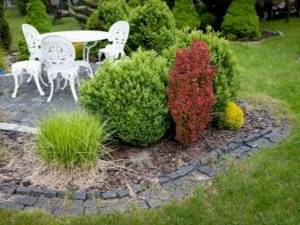
Instructions
To properly plant a bush, you should follow the following simple instructions.
- You need to dig a hole for planting barberry in about 10–14 days. Its size should be 50x50x50 cm. If you plan to plant several bushes, then you should maintain a distance between holes of 1–1.5 meters, but to create a hedge, half a meter will be enough.
- Next, you should pour a little sand into the hole and lay drainage. After this, you need to add a layer of mixed soil and humus, 100 grams of mineral fertilizer, which will include phosphorus - this will be enough to provide an additional source of nutrition for the plant.
- The seedling should be placed vertically in the hole and its roots should be carefully straightened, covered with soil, but only to the level of the neck of the root system, and then the soil should be crushed a little to fix the bush.
- Organic material is used for mulching, because it will not only act as a fertilizer, but will also help maintain the necessary temperature and moisture for the normal development of the root system. Mulching helps create optimal air-gas exchange.
- Finally, it is worth watering the bush, as well as trimming the tops of the shoots - for growth it is enough to leave only 5-7 buds.
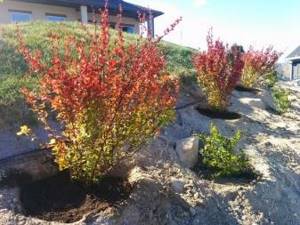
Planting barberry seedlings
Planting of seedlings begins in the spring, when it is warm enough outside and there is no risk of night frosts. In this case, the buds on the shoots should remain dormant.
Due to their high survival rate, shrubs rarely die. When purchasing planting specimens with closed roots, autumn planting of barberry can be done 30 days before frost. This specimen was kept in a special container, so its root system is already formed and is not afraid of moving into open soil.
In order for the future shrub to have a rich color and decorative effect, it is important to choose the most illuminated areas of the garden. Certain types of barberry are not afraid of being in shady conditions, but in the absence of light they fade and lose their bright color. Specimens with multi-colored shades on the petals and crown need the most abundant lighting.
There are no special restrictions when choosing soil for planting seedlings. The shrub grows well on sand, rocky or clay soils, as well as on combined substrates. The main thing is that the land is not swampy, because... Excess moisture leads to rotting of the root system. A good drainage layer will prevent the problem.
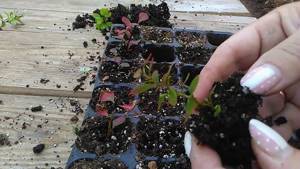
The following materials are used to create it:
- Pebbles.
- Brick.
- Crushed stone.
- Stones with different fractions.
- Construction garbage.
Planting seedlings is carried out according to the following instructions:
- Construction of the recess begins 10-14 days before disembarkation. The optimal parameters of the pit are 50 x 50 x 50 cm. If several plants are expected to be planted, the distance between the pits is chosen at the rate of 1-1.5 cm. When organizing a hedge - 50 cm.
- Next, sand is poured into the hole and a drainage layer is made.
- A substrate of humus and mixed soil is poured onto the bottom.
- In order to saturate the soil with nutrients, use 100 g of mineral fertilizers containing phosphorus.
- The seedling is fixed vertically, carefully straightening the roots.
- Then it is covered with soil to the level of the root neck and the soil is slightly pressed down with your hands. It is important to make sure that the bush is securely in the ground.
- The top part of the soil is covered with a layer of organic mulch. It is intended to additionally fertilize the substrate and maintain optimal root temperature. Mulching also improves air exchange and promotes good nutrition of the bush.
- Finally, you need to water the bush and trim the tops of the shoots, leaving 5-7 buds.
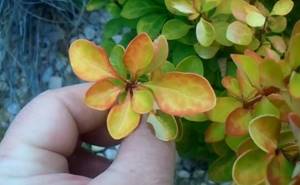
If you want to grow barberry from seeds, you need to properly prepare the seed or purchase it at a gardening store. In the first case, barberry seeds are extracted from ripened berries and passed through a sieve to separate the pulp.
We recommend that you read Everything about barberry propagation
They also need to be treated with a weak manganese solution and washed with clean water. Then the seeded specimens are poured into a tray with damp sand and kept in the refrigerator until spring. Under such conditions, the seeds will be stratified for planting in open ground.
What domestic plant varieties are there?
The most popular varieties for home growing are decorative varieties of Thunberg barberry. This species has dozens of varieties of various shapes and colors. Tall bushes are used as hedges, as they tolerate pruning well. Low-growing plants are suitable for alpine slides and flowerpots. Dwarf varieties of Thunberg barberry can have a spherical or columnar shape and a height of 30 to 100 cm. They grow slowly and do not need to be shaped.
The most popular dwarf varieties of Thunberg barberry:
- Atropurpurea Nana is a spherical shrub up to 60 cm in size. The shoots are thin, with small rounded foliage. In summer, barberry leaves are deep purple, in autumn they are fiery red. Blooms in late May - early June. Suitable for planting along paths, in rock gardens and flowerpots.
- Tiny Gold is a spherical bush with a diameter of up to 50 cm. The leaves are small, round, golden yellow. They become brighter in autumn. Used in landscape compositions to create contrast.
- Admiration is a slow-growing shrub up to 60 cm high, up to 1 m wide. The leaves are red with a light green or golden edge. The berries ripen in September-October and remain on the branches until mid-winter.
- Pink Queen is a spreading bush up to 1.5 m high. From a distance it appears pink. The leaves are red with pink and gray spots, scarlet in the fall. Good as a single lawn decoration.
- Helmond Pillar is a columnar bush up to 1.5 m high with crimson-purple leaves. This variety is often used for hedges.
Dwarf varieties can be grown on a windowsill like any houseplant. From left to right: Atropurpurea Nana, Tiny Gold, Admiration, Pink Queen, Helmond Pillar.
Description of barberry varieties with red leaves
There are many varieties of barberry with red leaves. Depending on the height of the bush they are divided:
- to dwarf;
- for medium height;
- to tall ones.
The first include the varieties Atropurpurea Nana (Atropurpurea Nana), Bagatelle (Bagatelle).
They are united by the small height of the bush. For example, Atropurpurea Nana reaches only half a meter in height. The aesthetic, miniature appearance of the plant contributes to its widespread use in landscape design.
Double-colored flowers are collected in inflorescences. The shoots have tripartite spines.
Atropurpurea Nana has high frost resistance. Even if the thermometer drops to -20°C, the plant feels comfortable.
When planted in a shaded area, the decorative red leaves of the plant turn green. Atropurpurea Nana begins to bear fruit at the age of five.
The Bagatelle variety reaches a height of 1 m. Young shoots have a red-brown color, but by autumn it changes to dark brown.
Deciduous shrubs Dates Red Lady and Red Carpet reach a height of 1-1.5 m and are classified as medium-sized. These varieties are resistant to diseases such as powdery mildew and rust. They are not afraid of severe frosts and drought. The only condition that ensures the comfortable existence of plants is planting in an open, sunlit area.
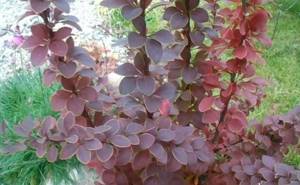
Dats Carpet has an unusual double-colored foliage. The bright red crown includes interspersed green leaves. This feature contributes to the widespread use of the plant in landscape design.
The tall group includes barberry varieties Atropurpurea, Golden Ring, Harlequin, Superba, Aurikoma, Helmond Pillar, Red Chief, Red Pillar (Red Pilar).
We recommend that you read Autumn planting of blackberries in the Moscow region
Among them, Golden Ring is the tallest, reaching 3 m in height.
The flowering process for these varieties occurs at the beginning of May. The buds are yellow in color. The bushes bear fruit in October. The fruits are red, except for the Red Chive variety, in which they have a rich pink color. The leaves are entire, rhombic-oval in shape with a slight point.
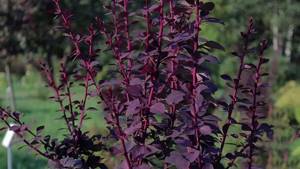
Barberry with red leaves is propagated in four ways: cuttings, seeds, layering, and dividing the bush. When propagated by seeds, varietal qualities (color, fruit size, etc.) may change. When using other methods, varietal properties are not lost.
The fruits of almost all varieties are inedible. The only exceptions are Superba and Auricoma (varieties of Ottawa barberry).
Methods for propagating barberry
There are several ways to propagate barberry:
- seeds;
- cuttings;
- dividing the bush;
- layering.
In order to decide which barberry propagation method is best for you, we will now take a look at each of them.
Seeds
As a rule, it is believed that the propagation of shrubs and trees by seeds (seeds), i.e. generative way - it is very long and ineffective, because varietal characteristics are most often not preserved when sowing seeds. But not in the case of barberry!
When and where to collect seeds?
At the end of autumn, you can collect seeds (i.e. berries) directly from the bushes of the variety you like.
How to plant barberry with seeds:
Rinse the seeds from the pulp (if you decide to collect the fruits yourself) and dry them, and then store them until the end of winter or beginning of spring.
In February, place the seeds on artificial stratification (for example, sow them on sand and put them in a closed container under the snow, either in the basement/cellar, or in the refrigerator. But first, soak them in plain water for 2-3 days.
In the fall, you can transplant seedlings from a greenhouse or containers to a permanent place in open ground.
Video: barberry from seeds
Cuttings
Of course, the main advantage of barberry cuttings is the 100% preservation of varietal characteristics.
Barberry can be propagated by both green and lignified cuttings. But often they use the first method, i.e. Cuttings are taken in the summer, not in the fall.
Green cuttings
Step-by-step instructions for propagating barberry using green cuttings:
Green cuttings are harvested in the second half of June and early July.
- To do this, take young annual growths: break out cuttings with “heels” (but you can also do without “heels”, just a 10 cm long cutting with 2-3 internodes or 4-5 growth buds, while making an oblique cut from below, and a straight cut from above ).
- Then the lower leaves are completely removed, leaving only a few upper ones (and it is better to leave half of each of them).
- To improve rooting, you can place the lower part of the cuttings for several hours (up to 12 hours) in a solution of one of the root stimulants (Kornevin or Heteroauxin) or dip them in dry powder.
- Next, the cuttings are placed in a glass of water for germination (only the lower part of the cutting without leaves should be in the water).
Video: barberry cuttings
Lignified cuttings
Of course, you can try to cut barberry in the fall (before the onset of frost), but this is not so easy: you need to cut longer 15-20 centimeter cuttings, with part of 2-year-old wood, and save them until spring, digging them in the garden bed in a trench or in wet sand in a cellar (basement), at 0...+4 degrees.
And in the spring, transplant into pots or directly onto the garden bed and cover with film or a glass/cut bottle (to create a greenhouse effect). Next, everything is the same as with green cuttings.
Dividing the bush
This is one of the simplest and most versatile ways to propagate any shrub.
So, first you need to carefully dig up the mother bush itself, and it is very important to minimally damage the root system. Next, you should divide the bush into several parts using a pruner (knife)
The sections are sprinkled with ash or crushed activated carbon. Plant the resulting seedlings in the standard way.
Plant the resulting seedlings in the standard way.
By layering
Barberry is propagated much less frequently by layering, but sometimes it turns out quite successfully.
Instructions:
- In spring (April-May), dig a small trench (furrow) 5-10 cm deep.
- Bend and place a long one-year-old shoot into this groove.
- Secure it on both sides (at the base and at the top) using a bracket or hook.
- Cover the top of the shoot with earth (you can additionally put a brick in the digging area).
- Mulch (so that the soil does not dry out) and water thoroughly.
Thus, now you know that barberry can be propagated in several ways. The main thing is to remember that in order to obtain a shrub with maternal qualities, it is recommended to use vegetative propagation methods, although plants similar to the parents also very often grow from seeds. Good luck!
How to grow barberry in the country
Barberry is a beautiful shrub with healthy berries that can perfectly improve your health.
Many summer residents prefer to plant it for its beautiful decorative appearance, which is provided by airy white flowers in the spring and a scattering of red berries in the fall.
And also leaves of all shades from green to purple, orange, scarlet.
There are varieties that are completely decorative, and there are also varieties that produce an excellent harvest of barberry berries, useful for many properties.
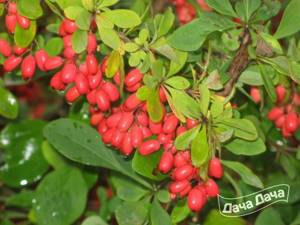
Amur barberry
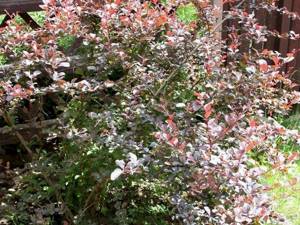
Barberry Robin Hood
What are the benefits of barberry berries?
Barberry berries are full of elements beneficial to human health. They contain vitamins C, E, K, tannins, organic acids - tartaric, malic, citric. Contains pectins, carotenoids and many other useful substances.
The berries are sour and have a pleasant aroma, so they are often used in cooking, in the production of liqueurs, sweets, marmalade, and as a tasty seasoning for meat dishes.
They have anti-inflammatory properties, tone the skin; the leaves, branches and even roots of barberry have the same properties. They pick berries with gloves because the bush is thorny. An infusion of barberry berries eliminates dandruff when rinsing hair.
Berries help lower blood pressure, relieve inflammation in cystitis, help with liver diseases - having choleretic properties, with pancreatitis, with damaged blood vessels.
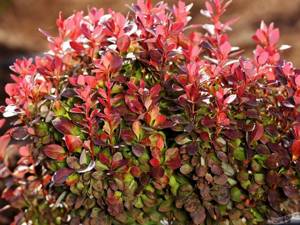

Barberry Thunberg "Vermillion"

Barberry Gagnepane
How to grow barberry seedlings from seeds at home
If you have barberry at your dacha, you can collect the seeds in November and even early December. Or buy seeds at the store. If you collected them in the fall, you need to immediately separate the seeds from the pulp.
To do this, place the berries in a warm place to soften them. Then the soft berries are placed in a sieve and tinder, and thus the seeds are separated from the pulp. Then they are soaked, the bad ones float. After this, the seeds are dried and they are ready for sowing.
If you bought dried berries, you must separate the seeds from the pulp in the same way. If you bought ready-made seeds, then they are ready for sowing. In winter, to grow barberry sprouts at home, you need to plant them immediately in deep and wide containers.
By the way, if you plant barberry directly in open ground, then you don’t have to separate the seeds from the pulp, and plant the berries in open ground in the spring. At home on the windowsill you can grow a decorative dwarf variety that will decorate your apartment.
Or you can grow a sprout of a bush, which you will transplant to your dacha in the spring. Barberry loves light loamy soils with a neutral pH. Before planting, harden the seeds in the refrigerator for 2 days, then they will sprout faster.
After planting the seed in a pot, transfer it to a glassed-in balcony. After 3-4 weeks, the barberry will sprout. And then it needs to be placed in a warm place under a phytolamp. After the sprout has strengthened, it is taken out to a glassed-in loggia or placed on a windowsill on the north side.
Barberry does not tolerate high room temperatures. To grow, it needs a cool temperature of +3- +5 C. On the loggia you will grow a sprout, which you will transplant into open ground in the spring.
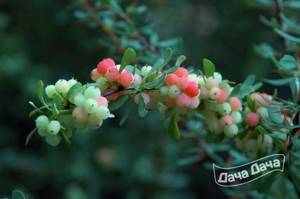
Wilson's barberry
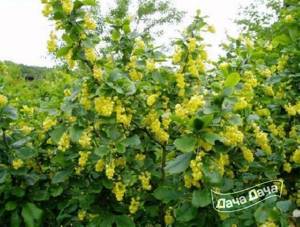
Gerald's barberry
Plant barberry in open ground
Barberry is planted in light loamy soil, with a neutral pH, no higher than 5-7. If the soil is acidic, add a handful of lime or wood ash.
If you are planting a hedge, then seedlings are planted in a trench, 2 seedlings per 1 sq.m. And if the bushes grow alone, then they are planted at a distance of 1.5 m from each other.
When planting, you need to dig holes or trenches 40 cm deep. Mix peat with humus 1:1, if the soil is clayey, and pour it into the bottom of the hole. Place each seedling in a hole and cover all the roots tightly with soil. Compact, water and cover with mulch.
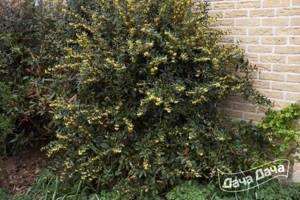
Barberry Juliana
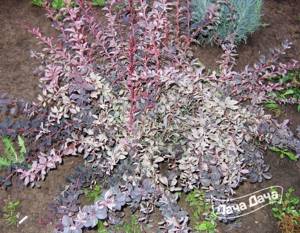

Barberry Ottawa "Silver Miles"
How to care for barberry
Barberry is unpretentious, it easily tolerates frost and heat. It is watered only once a week. The most important thing in caring for barberry is loosening the soil. The roots grow deep down, so they need oxygen, which they can only get by loosening the soil.
The soil under the barberry bush needs to be loosened once a week, preferably after watering the next day. The best fertilizers for barberry are organic vermicompost and saturation of the soil with earthworms.
The fact is that vermicompost and worms loosen the soil, making it light and saturated with oxygen. And this is what the barberry bush needs most of all. You can water it with liquid mineral fertilizers. In the spring, these fertilizers should contain nitrogen for better vegetation of the bush.
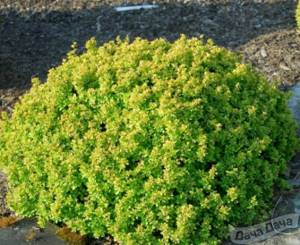
Barberry Thunberg Kobold (Kobold, Kobolt)
Barberry Juliana
The best types and varieties of barberry for the garden
Asian barberry is a type of barberry that grows well in the south of the Far East and Central Asia. This is a winter-hardy species that never freezes. The species bears fruit regularly, with abundant dark purple fruits. There are up to 20 branches on the inflorescence, the leaves are light green.
Thunberg barberry is a decorative species, distinguished by an abundance of varieties and unpretentiousness in agricultural technology. It is a deciduous shrub that grows up to 2.5 meters in height. Dwarf varieties are also common - up to 1 m in height. The leaves are colored orange and red in different shades.
The shape of the crown is similar to a sphere, rhombus, ovoid, in summer the leaves can be bright green, underneath they are bluish, and with the arrival of autumn the leaves acquire bright, red tones. It blooms in spring, abundantly with small flowers ranging from bright white to soft creamy tones. The fruits of barberry are bright scarlet or coral red.
Erecta - the variety grows in the form of a column, the branches are collected from below into a ball, extended upward in the form of a column, the branches form a rather lush column. It takes root well in mixborders, tolerates frost and cold, and has bright green leaves.
Red Rocket is a variety of shrub with purple leaves, columnar in shape, dense thick branches, elongated oval leaves, while the side branches always grow lower. This makes its shape very interesting. It is not very resistant to harsh winter climates, so it is better to grow in the south of Russia.
Amur barberry - can often be found in every forest in Primorye, in the south of Siberia, in Transbaikalia, in Japan. The crown is spreading, growing up to 3 m in height.
Young shoots have yellow branches, adults have brown and gray branches. The serrated leaves grow up to 10 cm. In spring and autumn the leaves are dark green. In autumn the leaves are purple, scarlet, red. The fruits are edible, bright scarlet, grow in large inflorescences collected in 20 - 25 clusters.

Barberry Thunberg Natasha
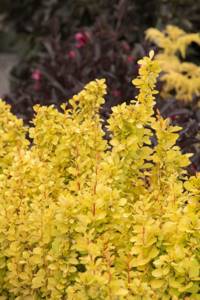
Barberry Thunberg Golden Pilar
Ways to propagate barberry
Many people think that this is a rather capricious plant. This is why some gardeners are afraid to grow it on their site. But barberry propagation and care in the future will not be difficult even for an amateur. Let's try to dispel the myths that surround the cultivation of this plant.
There are many ways of reproduction:
- cuttings;
- seeds;
- dividing the bush;
- layering.
Each of the above methods has its own disadvantages that should be taken into account. In many ways, the final result depends on the plant variety. For example, for Thunberg barberry, propagation by cuttings works best, since this species has quite a lot of young shoots that can be used for this. If you don’t know how to propagate the barberry growing in your front garden, gardeners recommend using several methods and identifying the most suitable one that gives quick results.
Propagation of barberry by seeds gives a fairly low percentage of germination. Another significant disadvantage of this method is the high possibility of loss of varietal characteristics.
Despite all the difficulties, gardeners claim that with the right approach and following all the subtleties, you will very soon see in your garden how beautiful barberry blooms.
Care
Maintenance is as simple as possible, so even the most inexperienced gardener can handle it.
Watering
If it rains periodically in your area, then there is no need to additionally water the barberry, since waterlogging of the soil is much more dangerous for the plant than drought. In hot weather, water the barberry once a week with warm water.
Top dressing
It is necessary to fertilize the barberry bush quite rarely. If in the first couple of years of life this needs to be done every spring, then approximately once every three years will be sufficient. Nitrogen fertilizers are best suited for barberry.
What else you need to remember about caring for barberry
In addition to proper watering and fertilizing, it is important to pay attention to the soil around the bush. From time to time you need to remove weeds and loosen the soil next to the barberry
Feeding and replanting
How to care for barberry after it has adapted to the soil. Already from the second year of life, the bush is fed 2 times a year. The spring procedure includes fertilizers rich in nitrogen and potassium. To do this, use 20–30 g of urea per bucket of water. In autumn the plant needs phosphorus.
Attention! Feeding this shrub more than twice a year is unacceptable.
When planting and caring for common barberry, you should not forget about replanting it. The procedure is carried out every 10–15 years. During this time, the soil is depleted and needs to be completely replaced.
The time for transplantation is late summer, early autumn. Before transplanting, the plant is well pruned and watered. A pitchfork is used to remove it from the soil.
The bushes, along with a lump of earth, are transferred to a new place on film or tarpaulin. The size of the planting hole corresponds to the size of the earthen ball.
After transplantation, abundant watering and mulching are carried out.
Barberry care
The barberry shrub, which even a novice gardener can plant and care for, does not require any difficult growing conditions. Moreover, caring for ordinary varieties and decorative ones is almost the same. Therefore, having once grown one variety of plant, you can safely plant other varieties without fear of having to learn new rules of care.
Caring for barberry will consist of the following:
- watering;
- loosening the soil;
- weeding;
- fertilization;
- pruning
The plant is not very afraid of the soil drying out, but is afraid of stagnant water. Therefore, only young seedlings should be watered (once a week). Adult plants are watered only during prolonged drought and no more than once a week. Watering should be done at the root, trying not to pour water on the leaves. Water for irrigation should not be cold.
For better growth, the soil near the barberry must be regularly loosened and weeds removed from the root circle area. To make caring for the shrub easier, the area next to it can be mulched with sawdust or peat.
Tall varieties of barberry require pruning. The first is produced in the spring on a 1-year-old plant, removing half the length of the shoots. Then the bush is pruned 2 times a year (at the beginning of June and at the end of August), removing dry and weak shoots, and also forming a neat crown.
Diseases and pests of barberry
Complete care of the shrub should also include an inspection of the crop for the appearance of symptoms of diseases that can affect barberry. These include:
- powdery mildew;
- rust;
- bacteriosis (bacterial cancer).
Rust most often occurs on bushes growing near cereal crops. The infection can be recognized by the characteristic bright red spots on the leaves. To rid barberry of this disease, it should be treated with one percent solutions of Bordeaux mixture or colloidal sulfur. Moreover, the treatment must be done 3 times, waiting 3 weeks before each repeated procedure. If measures are not taken in time, the leaves of the bush may begin to dry out and fall off.
Bacteriosis, or otherwise bacterial cancer, is manifested by the appearance of tumors, cracks and growths on the plant. Affected areas of the plant must be cut off and burned. After which the barberry must be treated with a preparation containing copper (for example, Bordeaux mixture).
Good care should also include inspecting the plant for pests. Barberry is dangerous:
- barberry aphid;
- flower moth;
- barberry sawfly.
Barberry, which even a novice gardener can grow and care for, can perfectly complement any garden. And the diversity of its varieties and species ensures its wide use both as a fruit plant, and as a separate ornamental shrub, and as a shrub for hedges.
https://youtube.com/watch?v=9WoqFLW_9NA
Purple barberry pruning and pest control
Those who grow barberry claim that pruning is the most difficult part of caring for it. The fact is that the shoots of the plant are quite prickly, especially when dried, when they, in fact, need to be removed. Therefore, it is better to stock up on thick, long gloves. Removal is carried out in the spring; it is subject to not only dry, but also weak, diseased, frost-damaged shoots - they can be easily recognized by the absence of green foliage.
If you have barberry growing for a hedge, then you can prune it after flowering and until the coldest weather, excluding the period when barberry ripens - the berries will fall off.
Unfortunately, barberry bushes attract all kinds of pests, and they can also suffer from some diseases. Here are just a few signs of problems and how to fix them:
- Wrinkling and drying of healthy leaves is a sign of the presence of barberry aphids. You can get rid of it either with the help of special preparations or folk methods: infusion of garlic, hot pepper, etc.
- White coating on the leaves indicates powdery mildew. This is one of the most popular diseases of this plant. it is easier to prevent than to get rid of it later: every three weeks, starting from the moment the leaves bloom, spray the bushes with a 0.5% solution of colloidal sulfur. If you doubt that your barberry is healthy, photos of plants infected with powdery mildew can always be found in special sources and a comparison can be made.
- Bright orange spots are a sign of rust or fusarium. An advanced disease leads to the death of shoots and entire bushes. To avoid this, at the first manifestations, spray the bushes with a 1.5% solution of colloidal sulfur or a 3% solution of Bordeaux mixture.
- Barberry bacteriosis is one of the most common causes of barberry cancer. It begins with the appearance of dark oblong spots. Without timely measures, bushes die. To avoid this, spray the bushes twice (before and after flowering) with a 4% solution of copper oxychloride.
How to care for barberry during winter sowing
If you sow barberry seeds before winter, then its seedlings will appear in early - mid-summer. Caring for them consists of constant weeding, regular watering of sprouts, as well as periodic summer treatment with a solution of humic acids in accordance with the instructions.
If you propagate red-leaved barberry using the indicated method, then approximately a third of the grown material will have a similar color. Other seedlings may have greenish or orange leaves.
In the first year, weak and small barberry sprouts are mulched with pine needles for the winter, and stronger ones are transferred to a growing bed.
How do you propagate barberry in your garden?
Recommendations and care tips
Properly organized planting allows you to minimize the care of decorative barberry. In order for the shrub to have an attractive appearance and bear fruit abundantly, it is necessary to water it properly and feed it in a timely manner. Pruning is not necessary, but will help the plant form a beautiful crown. With properly organized care, barberry will delight the owners of the site with its beautiful color and amazing aroma from May to October.
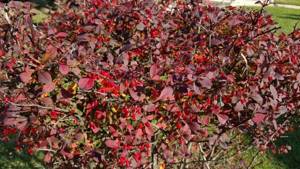
Watering and fertilizing
It is better to dry out barberry than to overdo it with watering. For a young plant, 1 bucket of water once a week will be enough. The soil must be wetted to a depth of at least 40 cm. Water is poured strictly at the root, trying not to wet the leaves on the lower branches. In rainy weather, soil moisture must be completely avoided.
In the second year of life, barberry will need feeding. Fertilizers applied during planting will be completely absorbed, so it is necessary to replenish the supply of nutrients. If the shrub has successfully completed the rooting period, it should be supported during active growth. It is not necessary to fertilize the plant annually; once every 3 years is sufficient.
For edible varieties of barberry, there are certain feeding rules. A portion of nitrogen fertilizers is applied to the soil every spring. In mid-summer, mineral fertilizing is carried out. In the fall, potassium phosphate mixtures are added.
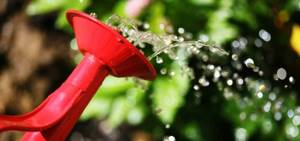
Trimming
Barberry responds excellently to pruning. The shape of the shrub crown is easy to shape and control. Plants tolerate cutting well. The specifics of the procedure depend on the final goal. There are three trimming options:
Rejuvenation. The procedure is carried out to increase decorativeness and increase productivity. Natural renewal can be achieved by periodically pruning branches that grow into the middle of the bush and do not bear berries. Barberry does not tolerate a drastic pruning of all unnecessary branches at once and recovers slowly. Rejuvenation is carried out for shrubs that are more than 10 years old. Sanitary cleaning. The procedure is carried out regularly twice a year - in spring and autumn. Remove diseased, dry, underdeveloped branches
The event is more important than other types of pruning, since it prevents infection of the plant by fungus and pest attacks. Formative pruning
Trimming allows you to maintain the attractive appearance of a regular garden and hedges.
The shape is controlled by shortening the branches by one-third or two-thirds of the length. Pruning is carried out twice a year - in June and August.
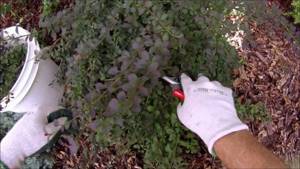
Autumn care and preparation for winter
In addition to pruning, mandatory autumn activities to prepare shrubs for winter include mulching, fertilizing, and shelter. Barberry bushes with mulched tree trunks tolerate cold well. This is a necessary procedure, especially for plants under 5 years old. Leaves, sawdust, and peat are laid at the base of the stems.
Also in the fall it is necessary to strengthen the plant with fertilizers. Potassium-phosphorus mixtures are dissolved in water and poured under the base of the bush. Manure and nitrogen fertilizers cannot be used in the fall, as they stimulate the growth of barberry.
Shrubs have good winter hardiness. Adult plants, from 3 years old, do not even need shelter for the winter. Varieties of southern origin and young barberry require high mulching and hilling. In a region with harsh winters, the upper part of the crown is covered with spruce branches or non-woven material.
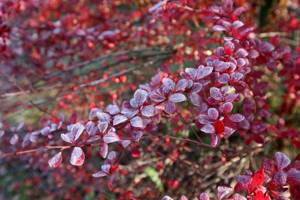
In the wild, barberry grows on forest edges and clearings, in ravines and on the slopes of ravines. But recently, more and more often you can find barberry bushes in summer cottages and city alleys. The popularity of barberry is explained by its good decorative qualities and healing properties, which are used in folk and traditional medicine.
Let's look at the main points for growing ornamental shrubs in the garden, and focus on options for using them in landscape design and for medicinal purposes.
Content
- Barberry is an ornamental shrub with beneficial properties video video
- Types of barberry video video
- Planting barberry on a summer cottage
- methods of propagation of different types of barberry
- when and where is the best time to plant barberry?
- soil preparation and planting
- Features of barberry care
- watering and fertilizing barberry
- protection from diseases and pests
- rules for pruning and wintering barberry bushes
Barberry is an ornamental shrub with beneficial properties.
Summer residents fell in love with barberry for its beautiful, elegant appearance and resistance to various weather conditions (drought and frosty winters).
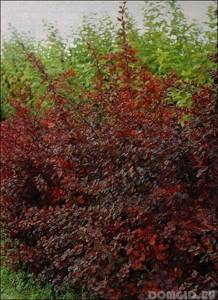
Barberry is a thorny shrub with simple small leaves. The arrangement of leaves on the shoots is single, in a spiral. The “candy bush” blooms from May to June with golden-yellow flowers collected in racemes or thyroid inflorescences.
The height of the plant, the color of the leaves and the shape of the fruit depend on the specific type of barberry. Therefore, when decorating a garden, you can choose the variety of barberry bush that is most suitable for landscape design.
When decorating a garden, barberry can be used as a single plant or in a group composition. Here are the options for using barberry in the landscape design of a summer cottage:
- A hedge made of barberry - the height of the shrub, its hard and sharp spines, about 20 mm long, allow the plant to be used as a fully functional fence. Within several years after planting, the bushes grow and fill the voids between the plantings with branches - a fairly dense and decorative hedge is formed. To speed up the process, it is necessary to trim the long branches of the bush. Such a fence can be used to separate a suburban area from a neighboring one, and to delimit space in the garden.

- Design of paths and borders - low-growing varieties of barberry visually expand the paths, giving them clear, regular shapes. To design paths, it is better to use spherical varieties. It is extremely undesirable to use barberry near children's playgrounds - while playing, children can easily get injured on the thorns of the bush.
- Rockeries and alpine hills - the unpretentiousness of the “candy bush” allows you to use it to create interesting landscape compositions. Barberry can be either the central element of an alpine hill or a background for other plants. It is better to plant dwarf and medium-sized varieties, depending on the size of the hill or rockery itself.

- Single plantings of barberry look appropriate in large garden plots and parks. Most often, one large shrub is planted, reaching a height of up to three meters. A barberry bush with large red leaves and yellow edging blends harmoniously with a green lawn. Such a plant will become a bright element of the entire garden.
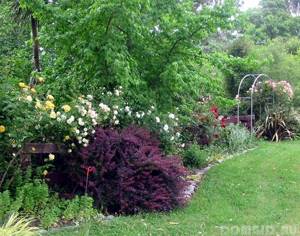
As a medicinal plant, barberry has proven itself since the times of Ancient Egypt. To treat many diseases, not only the fruits of the bush were used, but also its leaves, bark, and roots. Pharmacies in pre-revolutionary Russia sold barberry syrup and jam, which were recommended for scurvy, fever and indigestion.

The medicinal properties of barberry are explained by its unique and rich chemical composition. Rafts contain about 7% sugars (fructose and glucose), 5% acids (malic, tartaric and citric), 1% pectin, vitamin C and carotene. The main active ingredient in barberry is alkaloids (from 10 to 25 mg%), represented mainly by berberine.
In international practice, barberry-based medicines are used for stomach diseases, skin diseases, to stop internal bleeding and in the treatment of the gallbladder and liver.
Barberry berries are widely used in cooking: as a seasoning for many dishes, for making sauces and various confectionery products.
There are contraindications to the use of barberry fruits and medications based on it. First of all, restrictions apply to pregnant women and children.
Green, unripe barberry fruits are poisonous!
Types of barberry
In nature, there are about 500 species of barberry bushes. In Russia, the most common varieties are of two main types: common barberry and Thunberg barberry.
Common barberry has good winter hardiness and resistance to dust and drought. A thorny shrub up to 2.5 meters high with spreading arched shoots. The leaves are ovoid in shape and dark green in color. In May-June the shrub blooms with yellow honey-bearing flowers; barberry berries ripen by autumn.
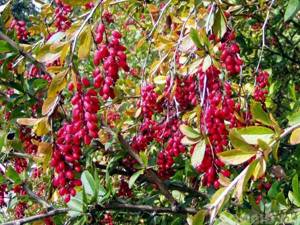
The fruits of the common barberry are quite suitable for consumption, and the plant itself can be used to create an unpretentious hedge, in single or group plantings.
Gardeners and summer residents especially loved the Thunberg barberry varieties, which have good decorative qualities. These are medium or low growing shrubs up to one meter high with spreading and dense shoots. The color of the shoots changes throughout the growing season from pale yellow to purple-brown. The coral-red fruits have a bitter taste and are not suitable for eating. Therefore, they can remain on the bush all winter and be a decoration of the garden even in the cold season.

Thunberg's barberry is less frost-resistant than its fellow common barberry, but it is more resistant to pests and diseases (powdery mildew and rust).
Planting barberry on a summer cottage
methods of propagation of barberry
Almost all types of barberry can be propagated vegetatively (cuttings, dividing the bush or root system) and seeds.
With vegetative propagation, it is possible to preserve the varietal characteristics of the plant. Cuttings are prepared from strong green shoots of the current year. For planting, it is better to use the middle part of the shoot with two pairs of leaves (two nodes) and one internode. The length of the cutting should be about 10 cm, and the diameter of the shoot should be 5 mm. The cuttings are cut at a right angle from above, and at a 45 degree angle from below.
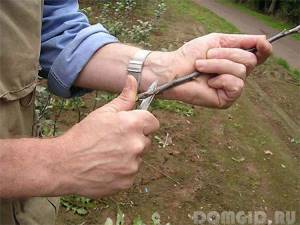
Lignified shoots will take longer to take root; for cuttings, they are cut in November and stored in a dark, cool place until spring.
Prepared cuttings are planted in boxes (a mixture of sand and peat in a ratio of 3:1) at an angle of 45 degrees. Rooting requires high indoor humidity (up to 85%) and an air temperature of 20-25 degrees. On hot days, seedlings need regular watering and spraying. It is better to leave cuttings that have taken root to strengthen in the same room for another 1-2 years.
Plants aged 3-5 years can be propagated by dividing the bush. In early spring, you need to dig up the barberry and carefully divide the bush into 2-3 parts using pruning shears. Each shrub is planted in a new prepared place.
If barberry shoots begin to branch above the soil level, then propagation by dividing the bush is impossible
To collect the seeds, barberry fruits are crushed, squeezed through a sieve, washed and dried. Seeds can be sown in autumn or spring.
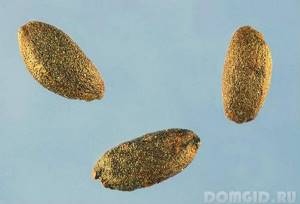
In autumn, the seeds are placed in furrows (1 cm deep), but it is important to prevent the soil from becoming waterlogged. Before spring sowing, seeds must undergo stratification (temperature 2-5 degrees, period 2-4 months).
when and where is the best time to plant barberry?
To plant barberry, you need to choose a well-lit place on the site, as it is a light-loving plant. Barberry will grow in the shade, but over time the leaves will lose their brightness and beauty. If barberry is planted for medicinal purposes, and the roots of the plant will be used as medicine, then it is better to plant the shrub in partial shade - this promotes active growth of the root system.

Most gardeners are inclined to believe that it is better to plant barberry in the fall, since in the spring the plant seedlings begin to grow early. Alternatively, spring planting of seedlings can be done before the buds open. In spring, stratified thorny bush seeds are also sown.
soil preparation and planting
To plant common barberry seeds in the fall, it is enough to dig the ground to a depth of 40 cm, remove the roots of the weeds and apply fertilizer (superphosphates, potassium salt, lime, organic fertilizers).
If you plan to plant Thunberg barberry seedlings or two-year-old barberry seedlings, then soil preparation may include the following steps:
- Dig the soil to a depth of 60 cm in the fall and remove all visible weeds.
- Dig planting holes measuring 40*40 cm.
- Sprinkle the bottom of the hole with a fertile layer of soil.
- Apply fertilizer (250 grams of superphosphate and 50 grams of potassium salt per bucket of organic fertilizer).
- Add soil fertilizer on top and mix a little (when planting, you need to make sure that the roots of the plant do not come into direct contact with the fertilizer - the root system can burn).
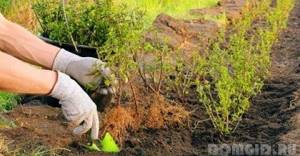
We plant barberry seedlings in the prepared holes, leveling the roots of the plant. After this, you need to water it, carefully sprinkle it with soil and compact it with your hands. The first fruits of barberry can be expected in two to three years.
Barberry seeds are sown to a depth of 0.5 cm and mulched with a layer of peat (1-1.5 cm). Seeds planted in spring should be watered regularly. The first berries will appear in the fourth or fifth year after planting.
Features of barberry care
watering and fertilizing barberry
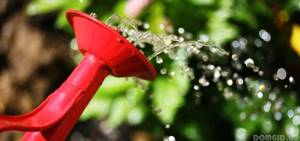
Young barberry seedlings need frequent watering. After the plant is well rooted and established, the bush should be watered once a week. It is advisable to loosen the soil around the bush and, if necessary, weed.
A year after planting, barberry begins to be fed. In the spring, the shrub should be watered with a solution of 2% urea solution, and in the fall, when digging, it is necessary to add compost or humus - 1-2 buckets for each plant (for adult shrubs - 2-3 buckets).
It is enough to feed separately growing barberry with complex universal fertilizers once every 3-4 years, but a hedge of barberry needs frequent feeding - at least twice a year.
protection from diseases and pests
When growing barberry in your summer cottage, you must remember that the plant can often be attacked by pests - moths and aphids. Therefore, the bushes must be inspected regularly.
Aphids cause leaves to dry out and wrinkle. To prevent its occurrence in the spring, the bush is sprayed with a tobacco solution (0.5 kg of shag should be brewed in a bucket of boiling water) or a soap solution (300 grams of laundry soap dissolved in 10 liters of water).
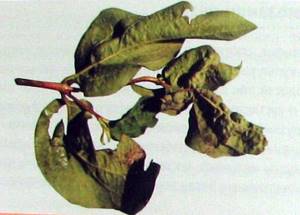
The moth eats barberry berries. It can be removed by treating the bush with chlorophos (0.1-0.3%) or decis (0.05-0.1%).
White plaque on the shoots, leaves and fruits of barberry is a sign of the appearance of powdery mildew, the causative agent of which is a fungus of the microsphere genus. The fungus multiplies quickly and infects healthy shoots of the plant. Severely affected leaves and branches are cut off and burned, while the rest need urgent treatment with a sulfur-lime mixture or colloidal sulfur solution. For prevention, the first treatment should be carried out during the leaf blooming period, the subsequent one – after two weeks.
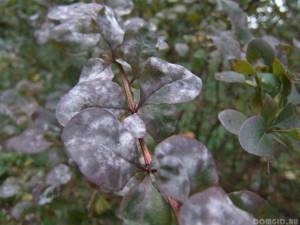
Common barberry can be affected by rust, especially if it grows near fields with cereal crops. Orange spots appear on young leaves (convex pads form on the inner leaf plate). Over time, the leaves may dry out completely and fall off. To prevent this, the plant must be sprayed with a solution of Bordeaux mixture (1%) or a solution of colloidal sulfur (1.5%). Thunberg barberry varieties are not affected by rust.
Bacteriosis (caused by bacteria of the genus Pseudomonas) can develop on the branches and leaves of barberry. The disease is accompanied by the appearance of dark, watery spots, cracked shoots, and uncharacteristic (cancerous) formations. Bacteriosis does not affect the fruits and flowers of barberry. As a therapeutic measure, the bush is sprayed with copper oxychloride (per 10 liters - 30-40 grams); processing is done before or after barberry blooms.
rules for pruning and wintering barberry bushes
Sanitary cleaning of barberry bushes should be carried out regularly. Thin, dry or overgrown branches are cut out.
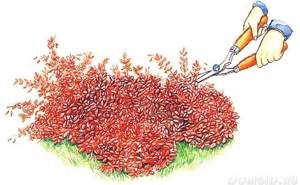
Barberry is also pruned when forming a decorative shrub shape. If barberry is used as a hedge, then the number and length of the stems are adjusted depending on the size of the hedge itself. If barberry acts as a central element in landscape design, then the bush becomes more powerful and lush. When you plan to harvest a good harvest of berries from barberry, you need to thin out the bush, since in the shade of the branches the plant will bear fruit poorly.
Pruning to rejuvenate barberry should be done in early spring (before buds open). In this case, it is necessary to remove old branches - cut them off almost at the base of the bush.
Common barberry can withstand frosty winters, but Thunberg barberry (especially in the first two years after planting) needs insulation with peat, dry leaves or spruce branches.
In principle, if we compare barberry with other ornamental and berry bushes, it requires less care, although it is distinguished by its universal use in landscape design, the treatment of many diseases and the preparation of a variety of culinary dishes.
Author: Sergey and Svetlana Khudentsov
0

